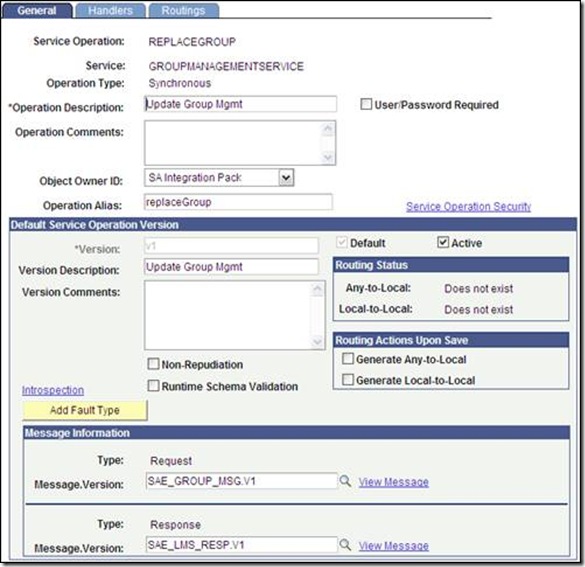****************************************************************************************************************************************************************************
-
-
Gateway ID/Connector ID setup at Node vs Routing level
The ConnectorID is not required at the Node as long as there are no Routings defined (with that node as a Target Node) where these routings are not using Connector Override on the routing or within PeopleCode.
Note that a gateway only needs to even be defined for outbound routings only (in other words if one had all inbound routings a gateway does not even need to be defined on the gateway page).
As long as this Node will always be used on routings that have its own connector override at the routing level then no Node connector needs to be defined.
-
-
****************************************************************************************************************************************************************************
-
-
Issue: Synchronous Service Operations : Multiple Active Routings
-
While working on SAIP, we found an issue invoking a synchronous service operation having multiple active routings (i.e. multiple receiver nodes). At a time we wanted to invoke that service opetation for only one of the multiple active routings.
Initially we decided, to use a OnRoute Handler (as was suggested in PeopleBooks) to pick the correct routing (i.e. the receiver node), but we identified a small issue with that approach too and then moved to extending sendMessage() method in CS SOA framework. Wherein instead of using
&response_msg = %IntBroker.SyncRequest(&request_msg);
-
we planned to use either
-
&response_msg = %IntBroker.SyncRequest(&request_msg, Node.TargetNode1);
-
or
-
&responseMsgArray = %IntBroker.SyncRequest([&MsgArray, &NodeNames]) ;
but only after verifying if the given node was in the receiver node list of that service operation.
Example Service Operation
Service Operation: General Tab

Service Operation: Handler Tab


Service Operation: Routings Tab

OnRote handler (Impementing PS_PT:Integration:IRouter - OnRouteSend )PeopleCode
-
method OnRouteSend
/+ &_MSG as Message +/
/+ Returns Integer +/
/+ Extends/implements PS_PT:Integration:IRouter.OnRouteSend +/
/* Variable Declaration */
Local any &aNodeList;
Local any &rootNode;
Local Rowset &TargetRowset;
Local string &TargetNode;
/* The node name is in the header part of the message */
&destinationNodes = CreateArray();
&TargetRowset = &_MSG.GetPartRowset(1);
&TargetNode = &TargetRowset(1).GetRecord(Record.SAE_EVENT_INFO).SAE_TARGET_NODE.Value;
&destinationNodes.Push(&TargetNode);
Return (%IntBroker_ROUTE_SOME);
end-method;
-
Issue
-
Here we had a issue wherein if we populate the &destinationNodes string array with a node name which is not not specified as a receiver node in the list of service operation routings, PeopleCode throws an exception and shows that service operation as “ERROR” in “Synchronous Services - Monitor”

-
Resolution
-
Then we realized that we can handle it in another way rather then using OnRote handler (Impementing PS_PT:Integration:IRouter - OnRouteSend ) to pick the correct routing. We decided on using &response = %IntBroker.SyncRequest(&p_msg, &TargetNode); .
However, before even executing this SyncRequest, we planned to verifyif that node is in the receiver node list of that service operation all this using a IB provided component interface (IB_ROUTINGDEFN_CI) for IB routing component.
We overridden the sendMessage() method in CS SOA framework
method sendMessage
/+ &p_msg as Message +/
/+ Returns Message +/
/+ Extends/implements SCC_SERVICE:AbstractServiceOperation.sendMessage +/
Local Message &response;
Local Rowset &TargetRowset;
Local string &TargetNode, &TargetServiceOperation;
Local SAE_FRAMEWORK:UTIL:GeneralUtil &objGeneralUtil = create SAE_FRAMEWORK:UTIL:GeneralUtil();
%This.log.logInfo(MsgGetText(14099, 8, ""));
&TargetRowset = &p_msg.GetPartRowset(1);
&TargetNode = &TargetRowset(1).GetRecord(Record.SAE_EVENT_INFO).SAE_TARGET_NODE.Value;
&TargetServiceOperation = &TargetRowset(1).GetRecord(Record.SAE_EVENT_INFO).SAE_TRGT_OPERATION.Value;
If (&objGeneralUtil.existsActiveRouting(&TargetServiceOperation, &TargetNode)) Then
&response = %IntBroker.SyncRequest(&p_msg, @("Node." | &TargetNode));
End-If;
Return &response;
end-method
-;
Here’s the magic code to find if a given node exists in the receiver node list of the specified service operation
-.
method existsActiveRouting
/+ &pServiceOperationName as String, +/
/+ &pNodeName as String +/
/+ Returns Boolean +/
Local number &indexServiceOperationRoutings;
Local ApiObject &oSession, &oSaeIbRoutingdefnCi, &oSaeIbRoutingdefnCiRet, &oSaeIbRoutingdefnCiCollection;
-
&oSession = %Session;
&oSession.PSMessagesMode = 1;
-
&oSaeIbRoutingdefnCi = &oSession.GetCompIntfc(CompIntfc.IB_ROUTINGDEFN_CI);
-
If &oSaeIbRoutingdefnCi = Null Then
rem "Unable to retrieve CI for routings.";
End-If;
-
&oSaeIbRoutingdefnCi.InteractiveMode = False;
&oSaeIbRoutingdefnCi.GetHistoryItems = True;
&oSaeIbRoutingdefnCi.EditHistoryItems = True;
-
&oSaeIbRoutingdefnCi.IB_OPERATIONNAME = &pServiceOperationName;
&oSaeIbRoutingdefnCiCollection = &oSaeIbRoutingdefnCi.find();
-
For &indexServiceOperationRoutings = 1 To &oSaeIbRoutingdefnCiCollection.Count;
&oSaeIbRoutingdefnCiRet = &oSaeIbRoutingdefnCiCollection.Item(&indexServiceOperationRoutings);
&oSaeIbRoutingdefnCiRet.Get();
If (&oSaeIbRoutingdefnCiRet.IB_OPERATIONNAME = &pServiceOperationName And
&oSaeIbRoutingdefnCiRet.EFF_STATUS = "A" And
&oSaeIbRoutingdefnCiRet.RECEIVERNODENAME = &pNodeName) Then
Return True;
End-If;
End-For;
Return False;
end-method;
-
****************************************************************************************************************************************************************************







